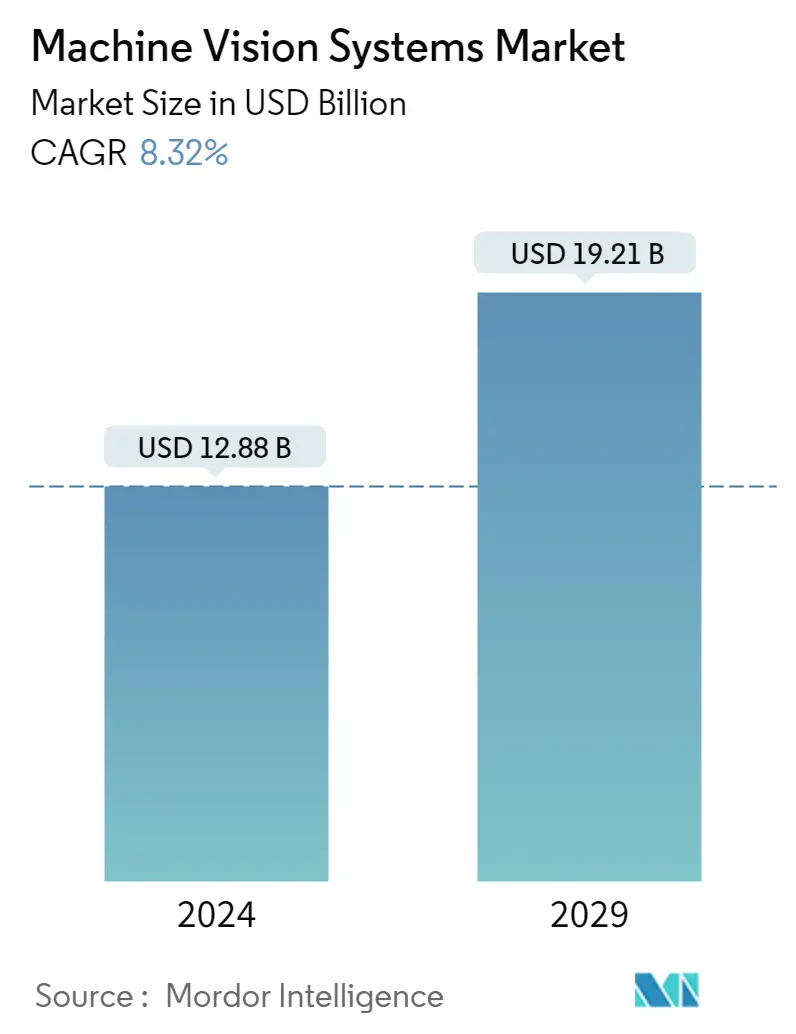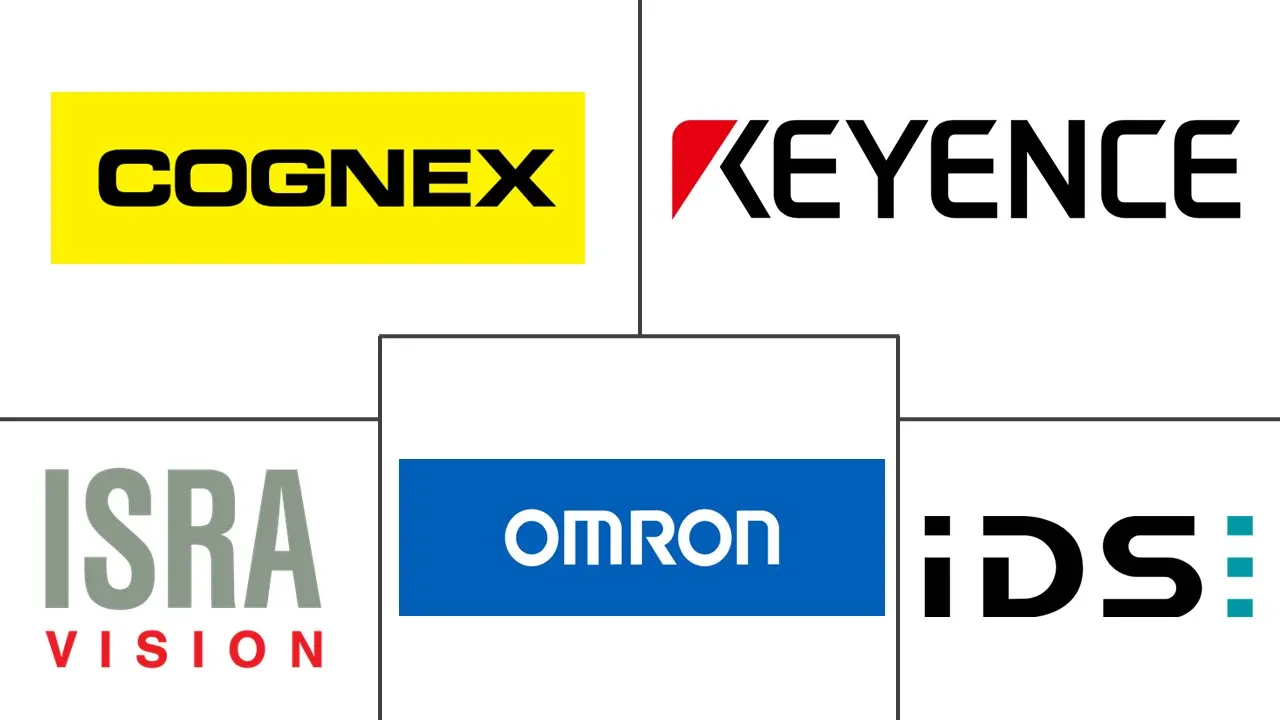Market Size of Machine Vision Systems Industry

| Study Period | 2019 - 2029 |
| Market Size (2024) | USD 12.88 Billion |
| Market Size (2029) | USD 19.21 Billion |
| CAGR (2024 - 2029) | 8.32 % |
| Fastest Growing Market | Asia Pacific |
| Largest Market | Asia Pacific |
Major Players
*Disclaimer: Major Players sorted in no particular order |
Machine Vision Systems Market Analysis
The Machine Vision Systems Market size is estimated at USD 12.88 billion in 2024, and is expected to reach USD 19.21 billion by 2029, growing at a CAGR of 8.32% during the forecast period (2024-2029).
Machine vision systems rely on digital sensors protected inside industrial cameras with specialized optics to acquire images so that computer hardware and software can process, analyze, and measure various characteristics for decision-making.
- Over the past few decades, industrial automation has evolved gradually, with few changes in market structure. But the pace of change is accelerating thanks to technology disruptions and macro trends such as reshoring, a global skilled-labor shortage, and environmental, social, and governance (ESG) efforts. In the recent past, the first wave of the COVID-19 pandemic created a slowdown in much of manufacturing. However, it was only temporary. As manufacturing returned, there was a boom in production. As companies began to return to work while maintaining social distancing as the new norm, there was an increased need for vision systems and automation systems to help fill the void, with more workers being unable to occupy the same workspace or unable to come in.
- The potential of industrial automation is most obvious in the tiny percentage of manufacturing sites known as “digital lighthouse factories.” These plants are leading the way in automation. A survey by the World Economic Forum found that 93% of lighthouse factories had gotten a growth benefit from their embrace of automation. Most of the growth benefit came from the ability to increase their output, with automation leading to new revenue streams for a handful of factories.
- As a result, machine vision is experiencing a surge in adoption, with organizations actively seeking more ways to deploy this transformative technology across their operations. Decision-makers are continually searching for ways to enhance productivity, quality, and traceability, and as a result, are identifying more applications on their manufacturing and logistics lines that can be improved with machine vision.
- Driving this growth is the need for improved product inspection and quality control in the manufacturing sector, as well as the growing demand for smarter collaborative robots in manufacturing and warehousing. Automation and machine vision technologies also improve operational efficiency and productivity, reduce production costs, and expand worker capabilities.
- Another factor driving growth is the need for improved product inspection and quality control in the manufacturing sector, as well as the growing demand for smarter collaborative robots in manufacturing and warehousing. Automation and machine vision technologies also improve operational efficiency and productivity, reduce production costs, and expand worker capabilities.
- However, the current market is experiencing a deficiency in adaptable software that effectively integrates high-quality graphics and user-friendly interfaces with code-centric algorithms. Thus, due to the aforementioned shortage of proficient individuals, the market encounters a hindrance in its expansion.
Machine Vision Systems Industry Segmentation
Machine vision systems indicate the substitution of human visual sense and judgment capabilities with a video camera and computer while performing an inspection task. It is the automatic acquisition and analysis of images to obtain the desired data for controlling or evaluating a specific part or activity.
The machine vision systems market is segmented by component (hardware [vision systems, cameras, optics and illumination systems, frame grabbers, and other types of hardware] and software), product (PC-based and smart camera-based), end-user industry (food and beverage, healthcare and pharmaceutical, logistics and retail, automotive, electronics and semiconductors, and other end-user industries), and geography (North America [United States and Canada], Europe [Germany, United Kingdom, France, Italy, Spain, and Rest of Europe], Asia-Pacific [China, Japan, South Korea, India, and Rest of Asia-Pacific], and rest of the world [Latin America and Middle East and Africa]). The market sizes and forecasts are provided in terms of value in USD for all the above segments.
| By Component | |||||||
| |||||||
| Software |
| By Product | |
| PC-based | |
| Smart Camera-based |
| By End-user Industry | |
| Food and Beverage | |
| Healthcare and Pharmaceutical | |
| Logistics and Retail | |
| Automotive | |
| Electronics and Semiconductors | |
| Other End-user Industries |
| By Geography | |||||||
| |||||||
| |||||||
| |||||||
| Australia and New Zealand |
Machine Vision Systems Market Size Summary
The machine vision systems market is poised for significant growth, driven by advancements in industrial automation and the increasing adoption of smart camera technologies. These systems, which utilize digital sensors and specialized optics to capture and analyze images, are becoming integral to enhancing productivity, quality, and traceability in manufacturing and logistics. The demand for improved product inspection and quality control, along with the rise of collaborative robots, is further propelling the market. Despite challenges such as a shortage of adaptable software and skilled professionals, the market is witnessing a surge in adoption as organizations seek to leverage machine vision for operational efficiency and cost reduction.
Regionally, the Asia-Pacific market is experiencing robust growth, with countries like China, Japan, South Korea, and India leading the charge due to their strong industrial bases and increasing focus on automation. The presence of major players such as Cognex Corporation, Keyence Corporation, and Omron Corporation, along with strategic partnerships and acquisitions, is enhancing product offerings and competitive positioning. Innovations like smart cameras and 3D color cameras are simplifying the implementation of machine vision systems, making them more accessible to a broader range of applications. As industries continue to embrace digital transformation and sustainability, the machine vision systems market is expected to expand significantly, offering new opportunities for growth and development.
Machine Vision Systems Market Size - Table of Contents
-
1. MARKET INSIGHTS
-
1.1 Market Overview
-
1.2 Industry Value Chain Analysis
-
1.3 Industry Attractiveness - Porter's Five Forces Analysis
-
1.3.1 Bargaining Power of Suppliers
-
1.3.2 Bargaining Power of Buyers
-
1.3.3 Threat of New Entrants
-
1.3.4 Threat of Substitutes
-
1.3.5 Intensity of Competitive Rivalry
-
-
-
2. MARKET SEGMENTATION
-
2.1 By Component
-
2.1.1 Hardware
-
2.1.1.1 Vision Systems
-
2.1.1.2 Cameras
-
2.1.1.3 Optics and Illumination Systems
-
2.1.1.4 Frame Grabbers
-
2.1.1.5 Other Types of Hardware
-
-
2.1.2 Software
-
-
2.2 By Product
-
2.2.1 PC-based
-
2.2.2 Smart Camera-based
-
-
2.3 By End-user Industry
-
2.3.1 Food and Beverage
-
2.3.2 Healthcare and Pharmaceutical
-
2.3.3 Logistics and Retail
-
2.3.4 Automotive
-
2.3.5 Electronics and Semiconductors
-
2.3.6 Other End-user Industries
-
-
2.4 By Geography
-
2.4.1 North America
-
2.4.1.1 United States
-
2.4.1.2 Canada
-
-
2.4.2 Europe
-
2.4.2.1 Germany
-
2.4.2.2 United Kingdom
-
2.4.2.3 France
-
2.4.2.4 Italy
-
2.4.2.5 Spain
-
-
2.4.3 Asia
-
2.4.3.1 China
-
2.4.3.2 Japan
-
2.4.3.3 South Korea
-
2.4.3.4 India
-
-
2.4.4 Australia and New Zealand
-
-
Machine Vision Systems Market Size FAQs
How big is the Machine Vision Systems Market?
The Machine Vision Systems Market size is expected to reach USD 12.88 billion in 2024 and grow at a CAGR of 8.32% to reach USD 19.21 billion by 2029.
What is the current Machine Vision Systems Market size?
In 2024, the Machine Vision Systems Market size is expected to reach USD 12.88 billion.

